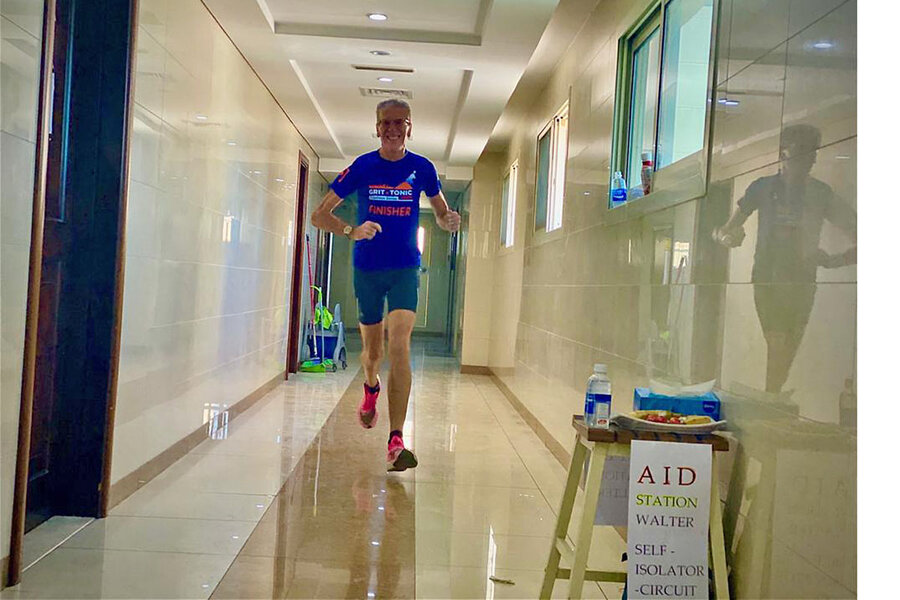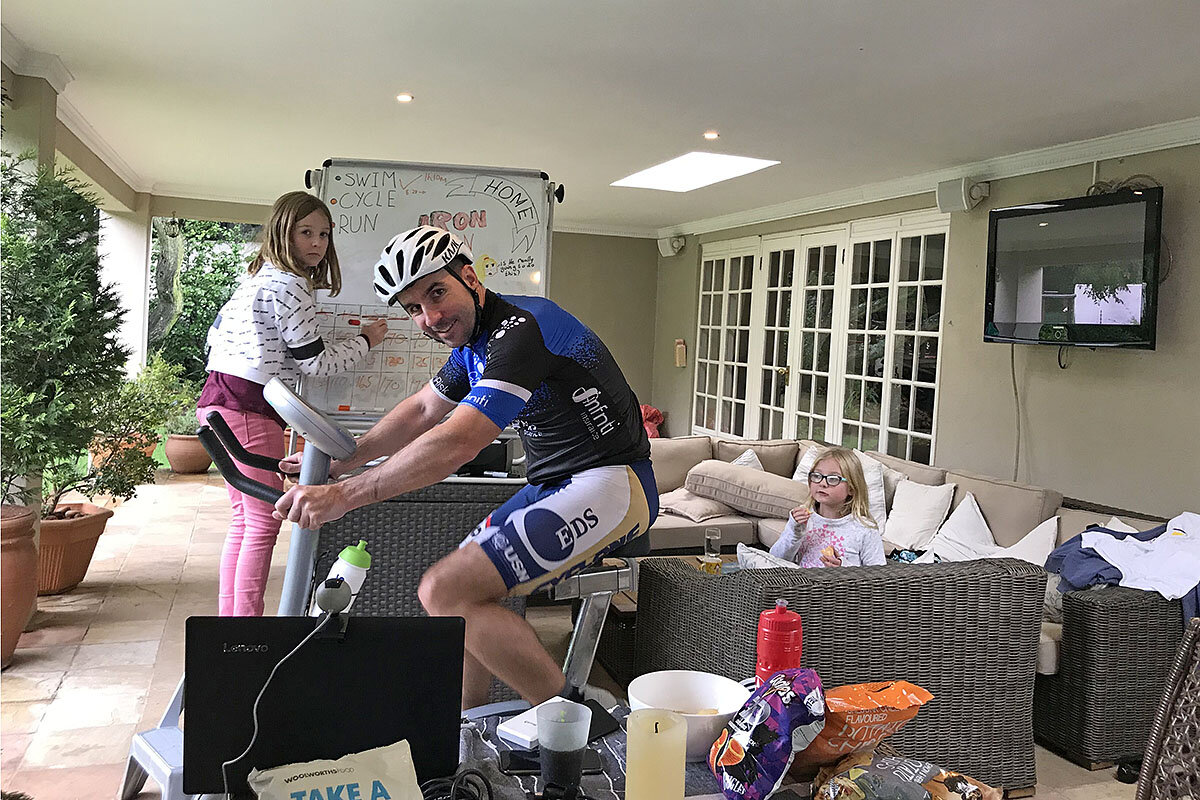Lapping the living room: Lockdown marathoners get creative
Loading...
| Johannesburg
It was one of the most grueling marathons that Wojciech Machnik had completed – and that was saying something. Mr. Machnik has run marathons that zigzag up mountain peaks. He has finished 26.2 miles in 90 degree heat and 95% humidity. One week last June, he ran six marathons in six Caribbean countries, just to see if he could.
But even Mr. Machnik had never run a marathon quite like this. On a quiet Sunday morning last month in Warsaw, Poland, he rounded his bed for the 5,626th time, and then plopped down on top of it.
“It was a crazy thing to do to commemorate a crazy moment in time,” he says. “So I thought, why not?”
Why We Wrote This
Running 5,000 laps around your bed? That may sound crazy – especially as lockdowns turn so many of us into couch potatoes. But for these joggers, marathons are a way to stay centered, challenged, and creative at an extremely trying time.
Around the world, government restrictions to fight the novel coronavirus have changed the way we exercise. For many, that’s meant brushing off dusty home gym equipment or streaming blocky feeds of trainers in their living rooms. But for a dedicated few, it’s given rise to a new kind of challenge: to run ever-longer distances in ever-smaller spaces.
Editor’s note: As a public service, all our coronavirus coverage is free. No paywall.
In China in February, an ultramarathon runner named Pan Shancu set the tone when he ran 31 miles through his small apartment, slurping noodles and taking videos of his stocking feet. In March in the south of France, furloughed restaurant manager Elisha Nochomovitz ran the length of his 23-foot balcony – with its sweeping view of the Pyrenees Mountains – 6,000 times to complete his own self-isolation marathon. And then, a week later, he did it again.
“This is literally a way to keep moving through this crisis,” says Rossyle Ayuro, a Filipino hospital administrator in Doha, Qatar, who recently ran a marathon from her kitchen, down her hallway, out the door, to the elevator and back – 1,400 times.
At-home marathons come with their own set of challenges, namely extreme boredom. But their adherents also see unusual upsides: no race-day jitters, and smooth-as-butter logistics. For runners like these, then, lockdown restrictions are less a limitation than a kind of extreme dare.
“Isn’t that what life is about, finding different challenges and conquering them?” says Shahieda Thungo, a South African ultramarathoner who’s been running 10 kilometer loops around her postage-stamp backyard in Soweto, near Johannesburg, ducking under her washing line on every loop. “We run marathons, we run ultras, but maybe it’s only by running in tiny circles that we can really test our minds and find our breaking point.”
Three weeks ago, Ms. Thungo was at the peak of her training for the Comrades, the world’s largest ultramarathon, which is run in South Africa each June. She was taking on weekly marathons like they were casual jogs.
And then the world around her started to shrink. As South Africa’s coronavirus cases ticked upward, the president called for restrictions on how many people could gather in one place. Races were canceled. Gyms closed their doors.
Ms. Thungo kept running, logging 20 mile jogs with just one or two friends, or solo runs at dawn near her house. But on March 23, South Africa announced a 21-day lockdown: no leaving home for anything except food or medicine.
“I thought, OK, well that might be an opportunity to try something completely different,” says Stuart Mann, who lives in Johannesburg and has run over 240 marathons and ultramarathons.
He took stock of his options: There was an exercise bike gathering dust in his garage. Sure, he hadn’t swum for exercise in 15 years, but he had a pool in his backyard. And his driveway was pretty long.
Why not try an Ironman triathlon? He could get out his lockdown jitters, and raise money for a favorite education charity.
So last Saturday, that’s exactly what he did. As cold rain lashed his shoulders, he swam 2.4 miles across his 36-foot-long pool. When he finished, he popped out, had a cup of tea, and headed for the bike on his veranda. For the next 5 1/2 hours, he chatted with friends online and read his 8-year-old daughter a chapter of “Harry Potter” as his feet spun through the miles – 112 of them, to be exact.
Then it was time for his driveway marathon, full of constant, sharp turns that pounded his knees.
“Not quite Comrades pain,” he says, referring to the 56 mile ultramarathon he’s completed 10 times, “but definitely getting there.”
For some runners, however, the tediousness of running back and forth across a tiny space has also been a way to trick their brains into thinking of something other than the colossal human crisis unfolding around them.
“There are no real answers for why this is happening, and this is a way to take my mind off of all that,” says Walter Tarello, an Italian veterinarian living in Dubai, who watched the horror in his home country unfold from afar. Last month, he ran a marathon through the eighth floor corridor of his apartment building, turning his head every loop to catch a glimpse of the skyscrapers arching into the dusty sky outside.
For Mr. Machnik, on the other hand, his bedroom marathon provided little in the way of scenic distractions. In fact, he’d clocked only a few loops before the room began to spin.
But he was determined to finish. For two years, Mr. Machnik, who runs a small adventure tour company, has been on a dogged mission – to run 100 marathons in 100 countries in a world record time.
A week and a half before, he’d finished marathon No. 97, on the island of Socotra in Yemen. He caught the last flight off the island. When he arrived back in Poland, he was put into a 14-day quarantine, confined to a small rented room.
There, he watched as the dates for marathons 98 and 99 passed by. Canceled. Finally, March 29 arrived: the day he was meant to run marathon 100.
“I wanted something to celebrate,” he says. And that something, he decided, would be 5,000 spins around a queen-size bed.
“Look, today this is what I can do. And this is probably my one chance in my life to do this,” he says. “You either take it or you don’t. You either say yes or you say no. And I said yes.”
Editor’s note: As a public service, all our coronavirus coverage is free. No paywall.









